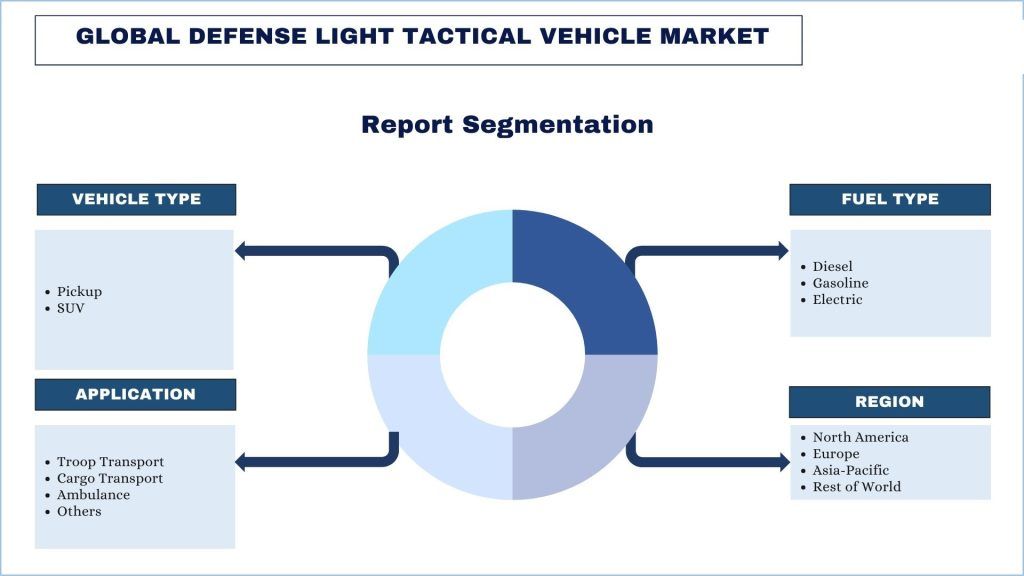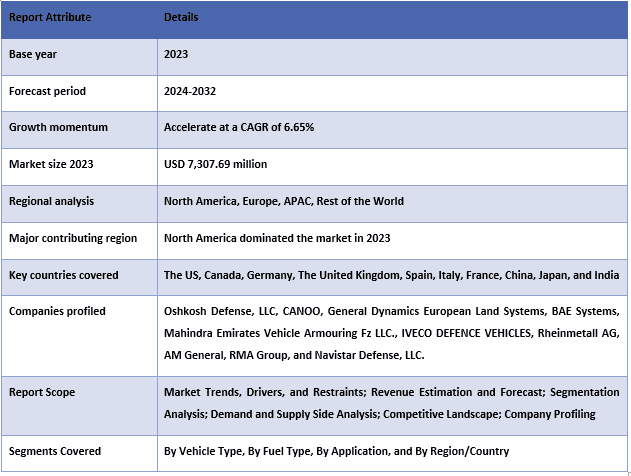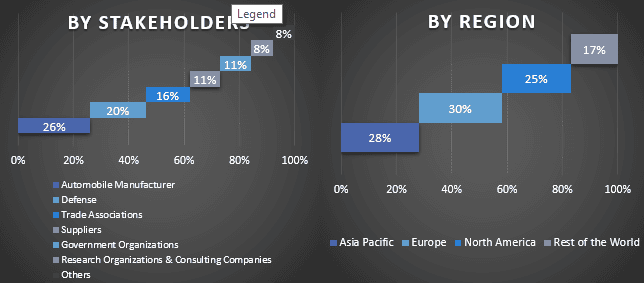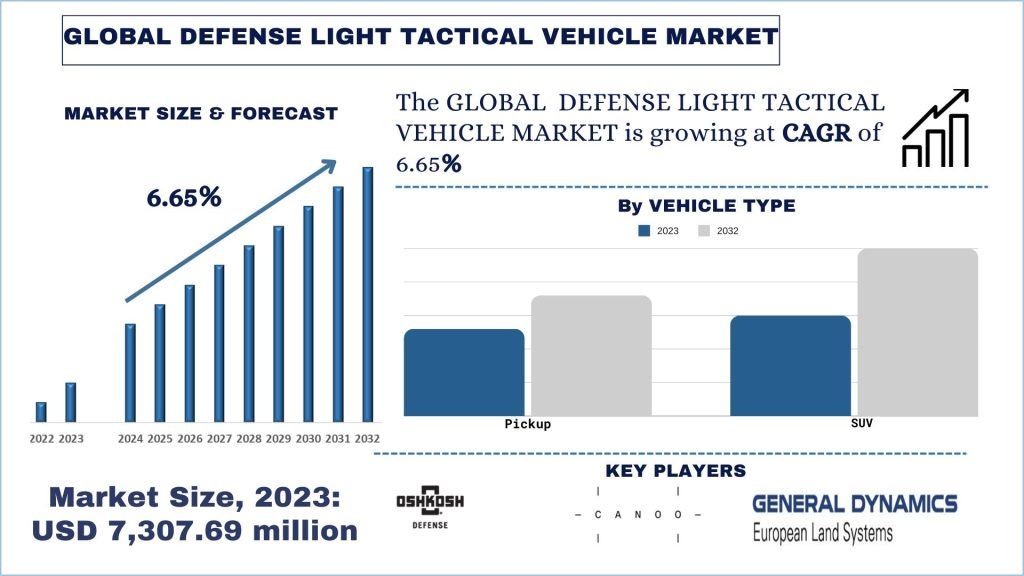방위 경량 전술 차량 시장: 현재 분석 및 예측 (2024-2032)
차량 유형 (픽업 및 SUV) 강조; 연료 유형 (디젤, 가솔린 및 전기); 용도 (병력 수송, 화물 수송, 구급차 및 드론); 및 지역/국가
방산 경량 전술 차량 시장 규모 및 예측
방산 경량 전술 차량 시장은 73억 769만 달러로 평가되었으며, 군대 현대화에 대한 수요 증가와 전 세계 국방비 지출 증가로 인해 예측 기간(2024-2032) 동안 약 6.65%의 강력한 연평균 성장률(CAGR)로 성장할 것으로 예상됩니다.
방산 경량 전술 차량 시장 분석
방산 경량 전술 차량은 군대가 기지 캠프든 전선이든 다양한 위치로 병사를 안전하게 수송하는 것과 같은 다양한 임무에 사용하는 견고한 특수 차량입니다. 글로벌 방산 환경은 진화하는 군사적 요구 사항과 민첩하고 다재다능하며 기술적으로 진보된 전투 차량의 필요성에 의해 변화하고 있습니다. 이러한 변화의 최전선에는 향후 몇 년 동안 상당한 성장을 이룰 것으로 예상되는 급성장하는 방산 경량 전술 차량(DLTV) 시장이 있습니다. DLTV 시장은 기술 혁신의 급증을 목격하고 있으며, 이러한 차량이 설계, 엔지니어링 및 배치되는 방식을 변화시키고 있습니다. 향상된 장갑 및 탄도 방어에서 첨단 통신 시스템 및 정교한 센서 패키지에 이르기까지 최신 DLTV는 군사 이동성 및 생존성의 기준을 재정의하고 있습니다. 또한 제조업체는 첨단 복합재 및 경량 합금과 같은 최첨단 재료를 활용하여 DLTV의 탑재량, 연료 효율성 및 전반적인 성능을 향상시킵니다. 이러한 기술적 우위에 대한 집중은 군대가 진화하는 위협 및 임무 요구 사항에 직면하여 전술적 우위를 유지하도록 보장하는 데 매우 중요합니다. 예를 들어, 2024년 5월 GM Defense와 Mistral Inc.는 UVision의 Hero-120 배회형 탄약을 GM Defense의 보병 분대 차량(ISV)에 통합하기 위한 파트너십을 발표했습니다. ISV의 새로운 변형은 Hero-120용으로 설계된 4개의 발사관이 장착되어 있어 이동성과 치사력을 결합하여 미군 전력의 전술적 역량을 잠재적으로 향상시킵니다.
방산 경량 전술 차량 시장 동향
전기화 및 하이브리드 파워트레인
지난 몇 년 동안 경량 전술 차량에서 전기화 및 하이브리드 파워트레인의 수용이 크게 증가했습니다. 이 추세는 군사 작전에서 현대화 및 지속 가능성을 향한 더 큰 움직임을 반영합니다. 미 육군은 첨단 차량 기술을 적극적으로 추구하면서 이러한 변화의 주요 사례입니다. 이와 관련하여 주목할 만한 개발은 선도적인 첨단 기술 모빌리티 회사인 Canoo가 2022년에 전기 경량 전술 차량을 도입한 것입니다. 이 회사는 분석 및 시연을 위해 새로운 경량 전술 차량을 미 육군에 인도했습니다. 이 차량은 극한 환경과 스텔스 조건을 위해 설계되었습니다. 이 차는 내구성이 뛰어나고 승객 중심적이며 배터리 안전을 고려하여 설계되었습니다. 또한 LTV는 무게를 늘리지 않고 강도를 높이기 위해 탄소 케블라를 통합합니다. 이러한 종류의 통합은 운영 비용을 줄여야 할 필요성을 해결할 뿐만 아니라 스텔스 기능을 개선하고 환경에 미치는 영향을 줄이는 데 점점 더 집중하고 있음을 강조합니다.
따라서 전기화에 대한 강조가 커짐에 따라 시장은 앞으로도 계속 성장할 가능성이 높습니다.

북미가 방산 경량 전술 차량 시장을 지배했습니다.
북미 방산 경량 전술 차량 시장은 지속적으로 글로벌 환경을 지배해 왔으며 이러한 추세는 예측 가능한 미래에도 계속될 것으로 예상됩니다. 북미의 주요 경제 강국인 미국과 캐나다는 군사력을 현대화하기 위해 국방 예산에 상당한 자금을 지속적으로 확보했습니다. 특히 미국은 전 세계 군사적 노력을 강화하고 기술적 우위를 유지하기 위해 최첨단 경량 전술 차량을 발전시키고 획득하는 데 중추적인 역할을 해왔습니다. 예를 들어, 2022년에 Oshkosh Defense는 2억 6,320만 달러 이상의 계약에 따라 미 육군용 장비 트레일러를 거의 500대 생산할 예정입니다. 국방부는 Oshkosh Defense에 약 466대의 향상된 중장비 운반 시스템 트레일러, 물류 제품 및 지원 서비스에 대한 고정 가격 계약을 체결했습니다. 이 차량은 네덜란드 하청업체인 Broshuis B.V.의 지원을 받아 2022년에서 2027년 사이에 생산될 예정입니다. 또한 북미에는 경량 전술 차량 생산을 전문으로 하는 여러 선도적인 방산 계약업체 및 제조업체가 있습니다. 이들 회사는 연구 개발에 막대한 투자를 하여 최첨단 기술과 고급 차량 플랫폼을 개발했습니다. 이 지역의 강력한 산업 기반과 엄격한 군사적 요구 사항은 지속적인 혁신과 고성능 경량 전술 차량 개발을 촉진했습니다.

방산 경량 전술 차량 산업 개요
방산 경량 전술 차량 시장은 경쟁적이고 집중되어 있으며, 글로벌 및 국제 플레이어는 거의 없습니다. 주요 플레이어는 파트너십, 계약, 협력, 신제품 출시, 지리적 확장, 인수 합병과 같은 다양한 성장 전략을 채택하여 시장 입지를 강화하고 있습니다. 시장에서 활동하는 주요 플레이어로는 Oshkosh Defense, LLC, CANOO, General Dynamics European Land Systems, BAE Systems, Mahindra Emirates Vehicle Armouring Fz LLC., IVECO DEFENCE VEHICLES, Rheinmetall AG, AM General, RMA Group 및 Navistar Defense, LLC 등이 있습니다.
방산 경량 전술 차량 시장 뉴스
2023년 2월, Oshkosh Defense는 아랍에미리트 아부다비에서 열린 International Defense Exhibition and Conference 2023에서 OGPK(Objective Gunner Protection Kit)가 장착된 4도어 Oshkosh Joint Light Tactical Vehicle(JLTV)을 선보였습니다.
2023년 8월, AM General은 Navistar Defense와 약 10,000대의 JLTV 트레일러를 제조하는 계약을 체결했습니다. JLTV 트레일러 하도급 계약을 통해 회사는 포트폴리오를 더욱 다양화하고 성장을 지원하며 미시시피에서의 운영을 확장할 수 있습니다.
방산 경량 전술 차량 시장 보고서 범위

이 보고서를 구매해야 하는 이유:
- 이 연구에는 인증된 주요 업계 전문가가 검증한 시장 규모 및 예측 분석이 포함되어 있습니다.
- 이 보고서는 전체 산업 성과에 대한 빠른 검토를 한눈에 제공합니다.
- 이 보고서는 주요 비즈니스 재무, 제품 포트폴리오, 확장 전략 및 최근 개발에 중점을 두고 주요 산업 동료에 대한 심층 분석을 다룹니다.
- 업계에 만연한 동인, 제약, 주요 동향 및 기회에 대한 자세한 조사.
- 이 연구는 다양한 부문에 걸쳐 시장을 포괄적으로 다룹니다.
- 산업에 대한 심층적인 지역 수준 분석.
맞춤화 옵션:
글로벌 방산 경량 전술 차량 시장은 요구 사항 또는 기타 시장 부문에 따라 더욱 맞춤화할 수 있습니다. 이 외에도 UMI는 귀하가 고유한 비즈니스 요구 사항을 가지고 있음을 이해하므로 귀하의 요구 사항에 완벽하게 맞는 보고서를 얻으려면 언제든지 저희에게 문의하십시오.
목차
방산 경량 전술 차량 시장 분석 (2024-2032) 연구 방법론
글로벌 방산 경량 전술 차량 시장의 과거 시장 분석, 현재 시장 추정, 미래 시장 예측은 전 세계 주요 지역에서 방산 경량 전술 차량의 채택을 만들고 분석하기 위해 수행된 세 가지 주요 단계였습니다. 과거 시장 수치를 수집하고 현재 시장 규모를 추정하기 위해 광범위한 2차 조사가 수행되었습니다. 둘째, 이러한 통찰력을 검증하기 위해 수많은 결과와 가정이 고려되었습니다. 또한 글로벌 방산 경량 전술 차량 시장의 가치 사슬 전반에 걸쳐 업계 전문가와 함께 광범위한 1차 인터뷰도 수행되었습니다. 1차 인터뷰를 통해 시장 수치를 가정하고 검증한 후, 전체 시장 규모를 예측하기 위해 하향식/상향식 접근 방식을 사용했습니다. 그 후, 시장 세분화 및 데이터 삼각 측량 방법을 채택하여 관련 산업의 세그먼트 및 하위 세그먼트의 시장 규모를 추정하고 분석했습니다. 자세한 방법론은 아래에 설명되어 있습니다.
과거 시장 규모 분석
1단계: 2차 자료 심층 연구:
연례 보고서 및 재무 제표, 성과 발표, 보도 자료 등 회사 내부 소스와 저널, 뉴스 및 기사, 정부 간행물, 경쟁사 간행물, 부문 보고서, 타사 데이터베이스 및 기타 신뢰할 수 있는 간행물을 포함한 외부 소스를 통해 방산 경량 전술 차량 시장의 과거 시장 규모를 얻기 위해 자세한 2차 연구가 수행되었습니다.
2단계: 시장 세분화:
방산 경량 전술 차량 시장의 과거 시장 규모를 확보한 후, 주요 지역에 대한 다양한 세그먼트 및 하위 세그먼트에 대한 과거 시장 통찰력과 점유율을 수집하기 위해 자세한 2차 분석을 수행했습니다. 보고서에는 차량 유형, 연료 유형 및 애플리케이션과 같은 주요 세그먼트가 포함되어 있습니다. 또한 해당 지역의 테스트 모델의 전반적인 채택을 평가하기 위해 국가 수준 분석을 수행했습니다.
3단계: 요인 분석:
다양한 세그먼트 및 하위 세그먼트의 과거 시장 규모를 확보한 후, 방산 경량 전술 차량 시장의 현재 시장 규모를 추정하기 위해 자세한 요인 분석을 수행했습니다. 또한 방산 경량 전술 차량 시장의 차량 유형, 연료 유형 및 애플리케이션과 같은 종속 변수 및 독립 변수를 사용하여 요인 분석을 수행했습니다. 전 세계 방산 경량 전술 차량 시장 부문에서 상위 파트너십, 합병 및 인수, 사업 확장 및 제품 출시를 고려하여 수요 및 공급측 시나리오에 대한 철저한 분석을 수행했습니다.
현재 시장 규모 추정 및 예측
현재 시장 규모 산정: 위 3단계의 실행 가능한 통찰력을 바탕으로 현재 시장 규모, 글로벌 방산 경량 전술 차량 시장의 주요 업체 및 세그먼트의 시장 점유율을 산출했습니다. 필요한 모든 백분율 점유율 분할 및 시장 세분화는 위에서 언급한 2차 접근 방식을 사용하여 결정되었으며 1차 인터뷰를 통해 검증되었습니다.
추정 및 예측: 시장 추정 및 예측을 위해 이해 관계자에게 제공되는 동인 및 추세, 제약 조건 및 기회를 포함한 다양한 요인에 가중치가 할당되었습니다. 이러한 요인을 분석한 후 관련 예측 기법, 즉 하향식/상향식 접근 방식을 적용하여 전 세계 주요 시장에서 다양한 세그먼트 및 하위 세그먼트에 대한 2032년 시장 예측을 산출했습니다. 시장 규모를 추정하기 위해 채택된 연구 방법론은 다음과 같습니다.
- 수익(USD) 측면에서 산업의 시장 규모와 국내 주요 시장에서 방산 경량 전술 차량 시장의 채택률
- 시장 세그먼트 및 하위 세그먼트의 모든 백분율 점유율, 분할 및 세분화
- 제공되는 제품 측면에서 글로벌 방산 경량 전술 차량 시장의 주요 업체. 또한 빠르게 성장하는 시장에서 경쟁하기 위해 이러한 업체가 채택한 성장 전략.
시장 규모 및 점유율 검증
1차 연구: 주요 지역의 최고 경영진(CXO/VP, 영업 책임자, 마케팅 책임자, 운영 책임자, 지역 책임자, 국가 책임자 등)을 포함한 핵심 오피니언 리더(KOL)와 심층 인터뷰를 실시했습니다. 그런 다음 1차 연구 결과를 요약하고 제시된 가설을 입증하기 위해 통계 분석을 수행했습니다. 1차 연구의 입력은 2차 결과와 통합되어 정보를 실행 가능한 통찰력으로 전환했습니다.
다양한 지역의 1차 참가자 분할

시장 엔지니어링
데이터 삼각 측량 기법은 전체 시장 추정을 완료하고 글로벌 방산 경량 전술 차량 시장의 각 세그먼트 및 하위 세그먼트에 대한 정확한 통계 수치를 얻기 위해 사용되었습니다. 데이터는 글로벌 방산 경량 전술 차량 시장에서 차량 유형, 연료 유형 및 애플리케이션 영역의 다양한 매개변수 및 추세를 연구한 후 여러 세그먼트 및 하위 세그먼트로 분할되었습니다.
글로벌 방산 경량 전술 차량 시장 연구의 주요 목표
글로벌 방산 경량 전술 차량 시장의 현재 및 미래 시장 동향이 연구에서 정확히 지적되었습니다. 투자자는 연구에서 수행된 정성적 및 정량적 분석에 대한 재량권을 투자 기반으로 삼기 위한 전략적 통찰력을 얻을 수 있습니다. 현재 및 미래 시장 동향은 지역 수준에서 시장의 전반적인 매력도를 결정하여 산업 참여자가 미개척 시장을 활용하여 선점자 이점을 누릴 수 있는 플랫폼을 제공했습니다. 연구의 다른 정량적 목표는 다음과 같습니다.
- 가치(USD) 측면에서 방산 경량 전술 차량 시장의 현재 및 예측 시장 규모를 분석합니다. 또한 다양한 세그먼트 및 하위 세그먼트의 현재 및 예측 시장 규모를 분석합니다.
- 연구의 세그먼트에는 차량 유형, 연료 유형 및 애플리케이션 영역이 포함됩니다.
- 방산 경량 전술 차량에 대한 규제 프레임워크 정의 및 분석
- 다양한 중개자의 존재와 관련된 가치 사슬을 분석하고 업계의 고객 및 경쟁사 행동을 분석합니다.
- 주요 지역에 대한 방산 경량 전술 차량 시장의 현재 및 예측 시장 규모를 분석합니다.
- 보고서에서 연구된 지역의 주요 국가에는 아시아 태평양, 유럽, 북미 및 기타 국가가 포함됩니다.
- 방산 경량 전술 차량 시장의 회사 프로필과 빠르게 성장하는 시장에서 유지하기 위해 시장 참여자가 채택한 성장 전략.
- 업계에 대한 심층 지역 수준 분석
자주 묻는 질문 자주 묻는 질문
Q1: 방산 경량 전술 차량 시장의 현재 시장 규모와 성장 잠재력은 어느 정도입니까?
Q2: 방위 경량 전술 차량 시장 성장의 주요 동인은 무엇입니까?
Q3: 차량 유형별로 가장 큰 방산 경전술 차량 시장 점유율을 차지하는 부문은 어디입니까?
Q4: 방산 경량 전술 차량 시장의 새로운 기술 및 트렌드는 무엇입니까?
Q5: 어느 지역이 방위 경량 전술 차량 시장을 지배할 것인가?
관련 보고서
이 상품을 구매한 고객님들도 함께 구매하신 상품











